Table of Contents
With the increase in digital transformation in industries, the traditional systems and legacy infrastructure are becoming harder to administer and combine with modern software environments. Compliance, security, or logistical barriers continue to inhibit the migration of many organizations to the cloud. Nevertheless, when it is done in the right way, cloud migration can transform the way your business operates, scales, and innovates.
What is Cloud Migration?
Cloud migration involves transferring digital assets, i.e., applications, databases, and services, from off-premises infrastructure to the cloud or across cloud platforms. This is aimed at improving the scalability, flexibility, and performance, as well as operational costs.
A clear cloud migration strategy would see that this complicated process occurs in a smooth and secure fashion, and it is in line with your business goals. A data-first approach will enable you to preserve data integrity, optimize infrastructure, and implement the approach to match the unique requirements of your organization.
It is appropriate to first have a review of the best practices to prepare a successful transition before discussing the most prominent cloud migration strategy.
The 7 Best Practices of Cloud Migration
Movement of workloads to cloud is not merely a technical undertaking it is a strategic project. By adhering to these cloud migration strategy best practices, one can prevent disruption and it will make the process smooth.
1. Set Clear and Realistic Goals
Determine the image of success before commencing migration. Your objectives are to improve the performance of your systems, increase their security, decrease costs, etc., and clearly set objectives help you to make the decisions. Be honest about deadlines – large migrations can be divided into small, manageable steps, and this can be more successful.
2. Design Architecture Aligned with Business Objectives
Design a cloud environment that will support both the present and the future objectives. The migration of clouds and integration with other solutions, such as data warehousing or analytics platforms, in most cases is more insightful in terms of performance and scalability. Engage a cloud architect to plot the appropriate architecture of your firm.
3. Build a Cross-Functional Team
Effective migrations demand cooperation. Add IT specialists, developers, data engineers, and major business stakeholders. The presence of the executive-level participation assists in making sure that the priorities of the whole organization can be matched and that the implementation processes can be unproblematic.
4. Evaluate a Multicloud Approach
A multicloud approach, or multiple cloud vendors, can be a good way to achieve flexibility, minimize vendor lock-in, and increase security.
Consider multicloud if:
- You do not want to completely rely on a single cloud provider.
- You require specific equipment from various vendors.
- You deal with controlled information that needs to be of a certain recalcitrance.
5. Cleanse and Organize Data Before Migration
Migration success is directly related to the data quality. Audit, clean, and organize all datasets- eliminate duplicates, correct the errors, and standardize formats. Organized and precise information reduces the problem of migration and provides the flawless work of your cloud environment at the very beginning of the process.
6. Leverage Low-Code or No-Code Platforms
In the migration process, it is not rare that temporary throwaway code is needed. With a low-code integration platform, such as iPaaS, it is possible to reduce manual code, speed up integration, and reduce post-migration technical debt. It simplifies the procedures and allows developers to work on strategic activities as opposed to momentary, one-time coding work.
7. Optimize Data Management with iPaaS
The Integration Platform as a Service (iPaaS) brings together data processes in the cloud system and on-premise. It is simple to do backup, sync, and monitor and ensures a steady flow of data, minimizes errors, enhances efficiency of operations, and provides ease of integration between applications within a cloud migration setup.

Common Challenges of Cloud Migration
Even with a strong cloud migration strategy, organizations may face several challenges.
1. Cost Management
Migration costs may easily become out of control without proper planning. Pay-as-you-go systems can result in unforeseeable costs. To ensure that you are in control of your budget, it can be helpful to create a detailed cost model and keep track of how it is being used.
2. Data Security and Compliance
Security and privacy of data are the biggest concerns. It is important to be sure that you follow industry-related rules (GDPR or HIPAA) and use effective encryption, access controls, and threat detection tools in your cloud environment.
3. Downtime and Service Disruptions
Migration can have a temporary impact on the availability of the systems. Tests, automated migration tools, and scheduling of downtime when there is less traffic can be used to mitigate disruption and minimize chances of transfer failures.
9 Cloud Migration Strategies
Organizations take various strategies based on resources, maturity of clouds, and business requirements. The strategies presented below outline successful techniques of an effective cloud migration strategy.
1. Rehost (Lift and Shift)
Rehosting relocates the current applications to the cloud with a few modifications. This low-cost, quick methodology is best suited to new cloud environment organizations and is a platform of many cloud migration strategy.
2. Refactor (Lift, Tinker, and Shift)
Refactoring gives minimal optimizations prior to migration to take advantage of cloud-native features. It improves performance and efficiency but does not entirely redesign applications, so it is an expedient and universally used measure in any large-scale cloud migration strategy.
3. Revise
The revise approach repurposes application code and architecture to make use of cloud-native services, including microservices, containers, and auto-scaling, to the fullest. It achieves maximum performance, scalability, and long-term advantages, which are ideal in support of highly developed cloud migration strategies.
4. Rebuild
Rebuilding is a re-creation of applications in the cloud. This method is time -consuming, however, it provides the best in the market of modern, scalable systems that can keep pace with your business growth and is a key component in a progressive cloud migration strategy.
5. Replace
Substituting old systems with ready-to-use cloud applications makes it easier to deploy and will cut back on the maintenance cost. Although customization is not allowed, the approach is effective in streamlining operations and can be incorporated into larger enterprise-wide plans of cloud migration strategies to realize efficiency in the long term.
6. Repurchase
SaaS adoption, or the repurchase strategy, involves dispensing old software and equipment with cloud-based systems. The use of an in-house tool as a substitute of Salesforce or HubSpot can fast-track implementation and reinforce any properly thought-out cloud migration strategy.
7. Replatform
Replatforming involves minor refinements like database or operating system upgrades to improve performance without changing the architecture. This is one of the strategies that are typically integrated with an enterprise-based, practical, and performance-oriented cloud migration strategy.
8. Retire
In the course of evaluation, obsolete or unnecessary systems may be phased out in order to cut down on the complexity and cost of operation. Unemployed components enhance efficiency and aid organizations in adopting a leaner and superior cloud migration strategy.
9. Retain
The applications are sometimes kept on-premises temporarily because of compliance, cost, or technical constraints. With a careful and measured approach to a wider cloud migration strategy, it is prudent to keep some systems to be implemented in phases to ease the transition to the cloud as the environment is conducive.
Conclusion
Migration to the cloud is not only a matter of data changing location, but it is a matter of reinventing business itself in the digital world. Defining clear objectives, adhering to best practices, and choosing the appropriate cloud migration strategy will help organizations to reduce risks, manage costs, and maximize performance in the cloud.
Nextwisi Solutions is a company that offers end-to-end cloud migration services to enterprises to facilitate a smooth migration to the modern infrastructure. Our team develops and implements tailored cloud solutions to improve scalability, build security, and promote continuous innovation. We also make sure that your cloud transformation is both efficient and smooth, regardless of whether you are rehosting, refactoring, or rebuilding, and future-ready.

Leave a Reply